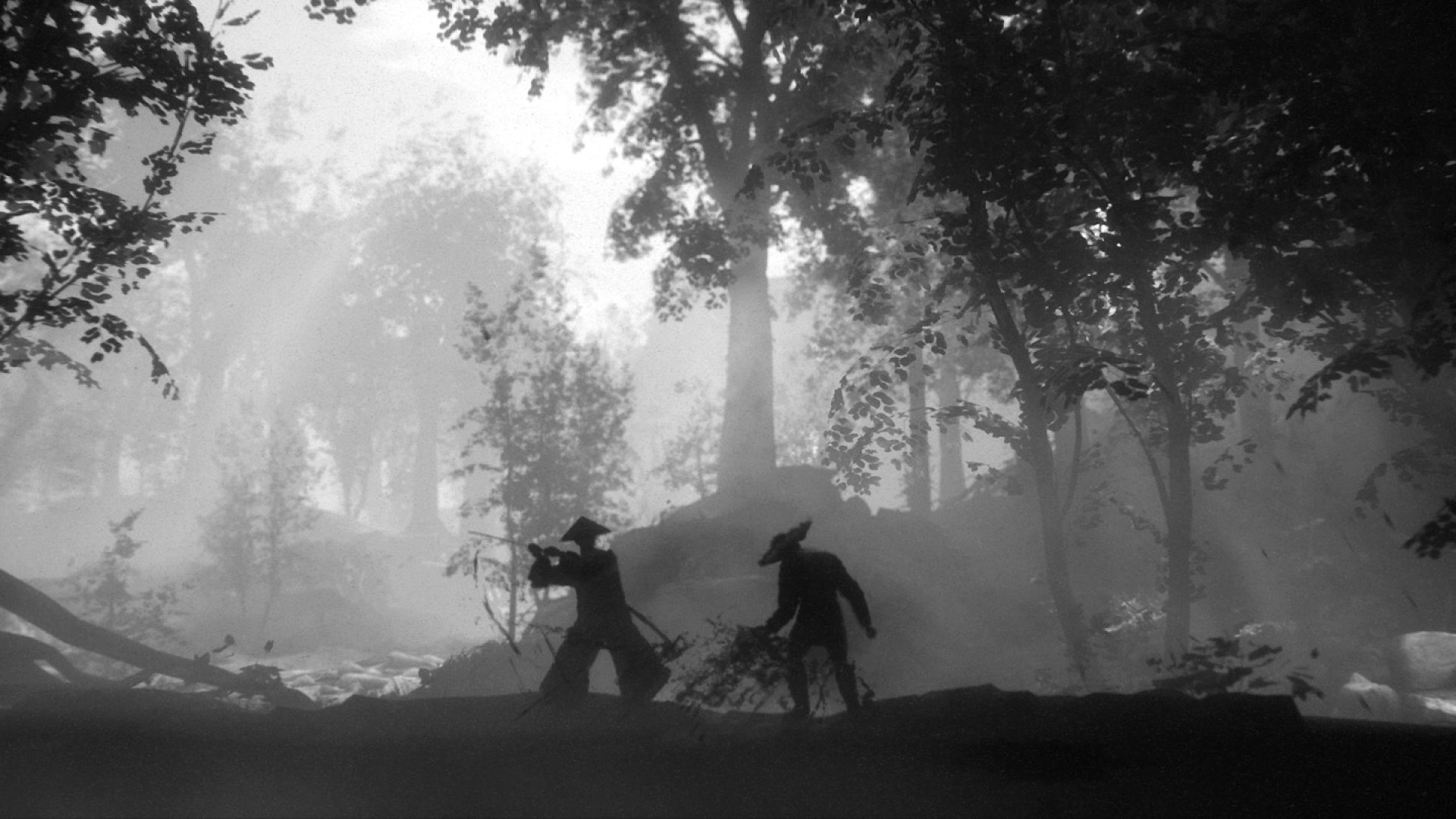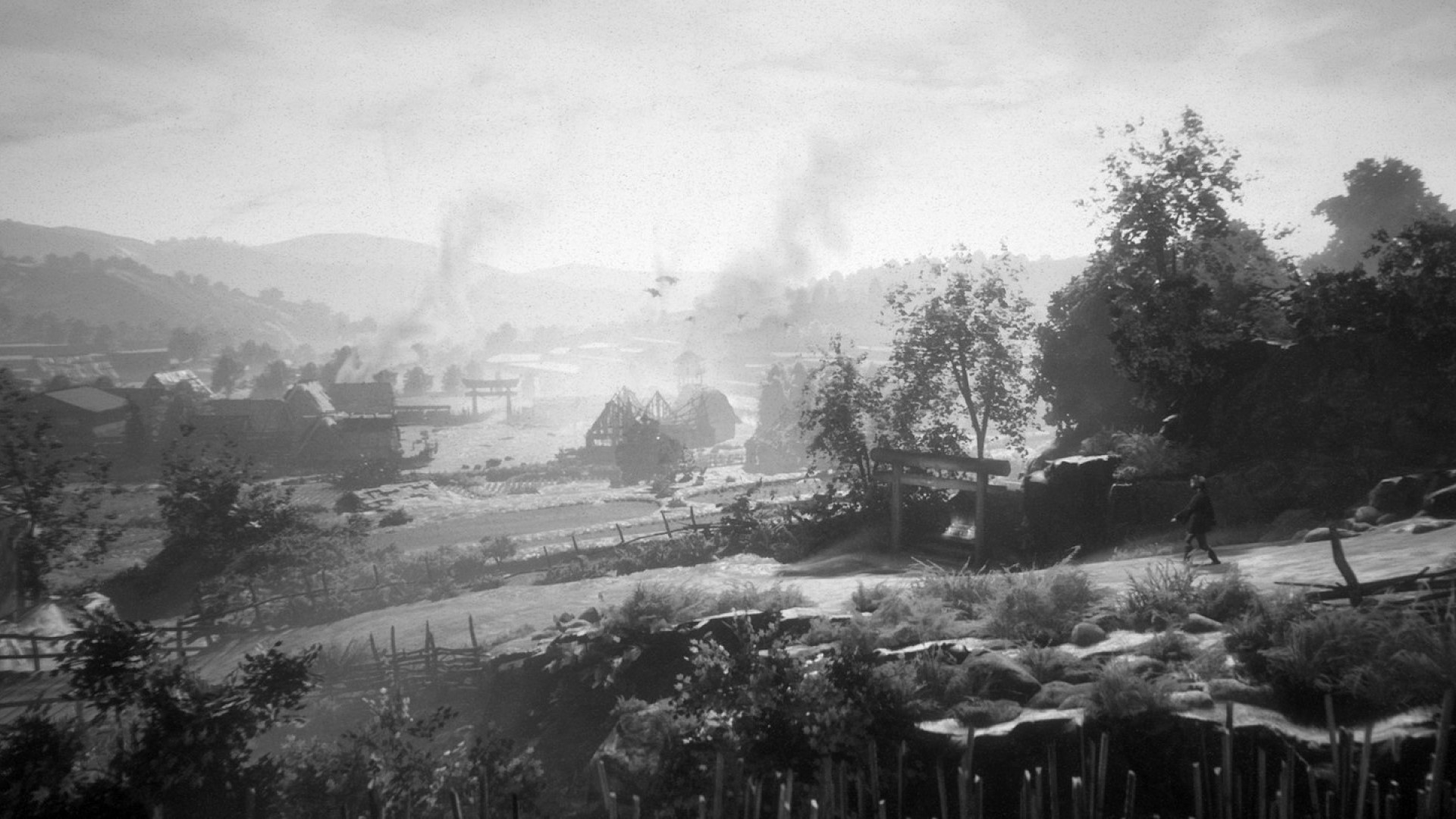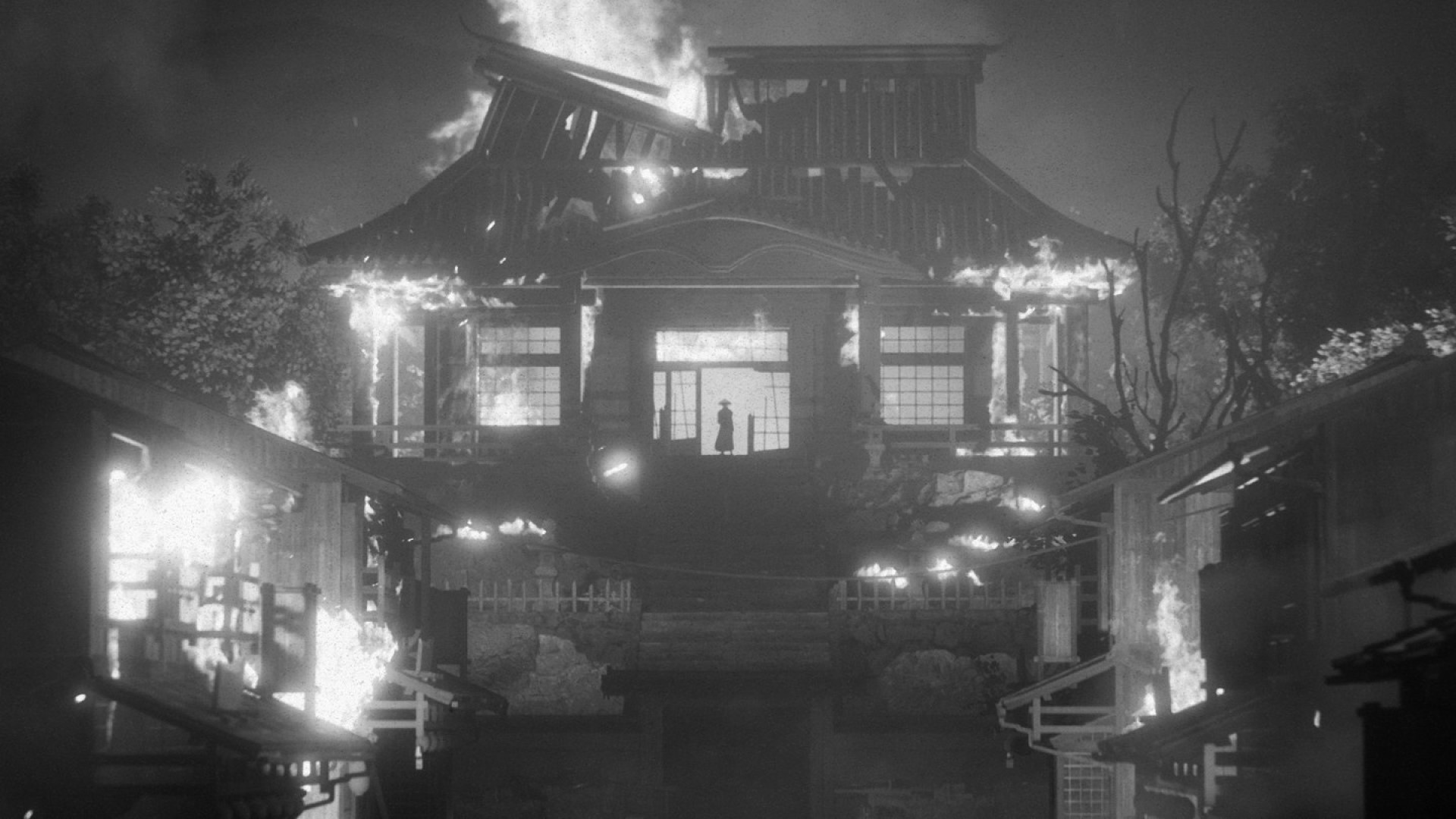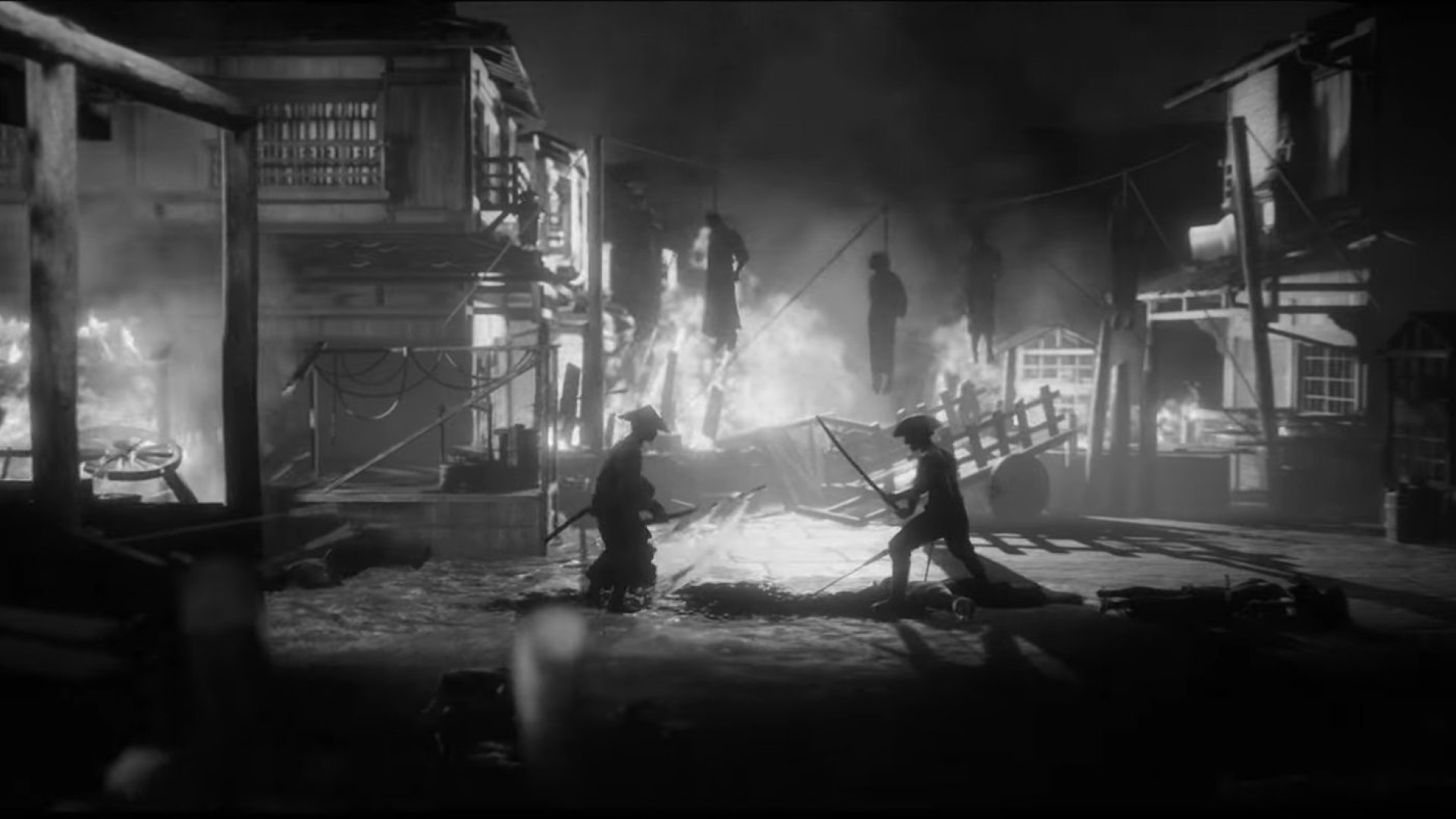
There are some games that can capture your attention even with a cursory glance- Flying Wild Hog and Devolver Digital’s upcoming Trek to Yomi looks to be one of them. Since its announcement, the action-adventure title’s period Japanese setting and gorgeous Akira Kurosawa-esque black-and-white aesthetic have been drawing plenty of attention, and the game continues to look more impressive with each new showing. Ahead of its looming launch on May 5, we recently reached out to its developers to learn more about the experience, and learned quite a bit in the process. Below, you can read our interview with Trek to Yomi’s game director Marcin Kryszpin.
"Each shot was analyzed in terms of composition, light, and strong points of the image. We tried to develop a visual language primarily by means of an appropriate balance of light and separation of planes."
During development, what’s the process been like for ensuring that Trek to Yomi, a game steeped in Japanese culture and history, delivers an experience that feels authentic to its setting?
We have spent tons of hours researching Japanese culture from the Edo period along with watching old Samurai movies, but not just that! We also did a deep dive into anime and cartoons, analyzing not only architecture or assets, but paying special attention to Samurai moves, their behavior, and the way of preparing our scenes. The key here was to separate the sets, establish the right balance of light to build atmosphere, and direct the player through the gameplay.
What is also very important is the fact that we received huge help from our consultant, Aki Tabei Matsunaga – a historian who specializes in the Edo period. She helped us with translating the dialogues and styling them to fit Edo Japan. She also made sure that our lore is as accurate as it can be in a video game; all dialogue and descriptions were stylized to fit the time period the game is set in. By using Japanese Edo-stylized lines and great Japanese actors, we tried to help players immerse themselves, to let them feel as if they were in Edo Japan.
Aki was our guardian of Japanese culture from the Edo period and made sure that we replicated that era of Japan as faithfully as we could. Of course, we weren’t able to implement everything, but we tried our best to do so.
Trek to Yomi’s Kurosawa-esque black-and-white aesthetic is obviously one of the game’s biggest draws, at least from a visual perspective- what motivated the decision to go with this look for the game?
Everything started with Leonard Menchiari and Devolver Digital. At this point we had worked with them on several projects and had developed a good relationship with them. When they pitched us the idea of doing a game set in the real Japan Edo period, our team was working on this crazy project called Devolverland Expo. Our team really liked the idea of a B&W game, and the project itself was right up Flying Wild Hog’s alley, so we immediately had ideas on how to develop and enhance the vision. Afterwards, Devolver connected us with Leonard and we started preparing for the production of Trek to Yomi.
Trek to Yomi is touting a cinematic experience, but what’s your approach been like to implementing that during gameplay itself? The black and white filter obviously contributes to that significantly, but what other steps have you taken to ensure that Trek to Yomi keeps pushing that cinematic nature?
Our main idea was to combine movie-ish style and gameplay. We were trying to balance these two aspects: exposing the cinematic nature, but not at the cost of playability. Each shot was analyzed in terms of composition, light, and strong points of the image. We tried to develop a visual language primarily by means of an appropriate balance of light and separation of planes.
Locations were prepared in a special way, based on references, and later adapted to our gameplay needs.
Trek to Yomi’s combat seems to be focused on precise, grounded, fast-paced action. Can you talk about how this functions in terms of gameplay, and what mechanics serve as the core of the combat experience?
The combat design was done in such a way to encourage players to observe and respond to enemies’ behavior accordingly. We tried to make combat as fast and fluent as possible, but also visually pleasing. Because of all that elements such as evading, parrying and counter attacking, enemies became the core of the combat.
"This is not a big game; on the normal difficulty level, it takes me about 5 hours to finish the game. We wanted to achieve this cinematic experience in order to show the player our story and acquaint them with the Edo period via collectibles."
Trek to Yomi’s shrines are an interesting take on checkpoints, especially with each shrine replenishing health and stamina only once. With that in mind, combined with the game’s more grounded combat, what would you say your approach to challenge and difficulty been in Trek to Yomi?
Shrines from the start were designed to play a major role in the game world. We wanted to achieve a feeling of relief when the player sees or hears one in the distance, because they would know it’s a safe place. At the same time, the fact that the shrines can be used only once will present the player with a weighty choice of using it in the desired moment, and to make it feel more natural and tactical. The difficulty of encounters and even whole chapters relied heavily on placement of the shrines.
What can you tell us about the progression mechanics in Trek to Yomi?
Progression mechanics were designed on two levels. On surface level, it was required to give the player necessary tools in correct moments so everyone could be able to finish the game. Therefore we made some combos and weapons impossible to miss. On a deeper level, some combos and tools were scattered in optional areas – these were not necessary, but would give more combat possibilities to the players who want it.
With so much of the experience being focused on storytelling and combat, what has that meant for your approach to level design and exploration in the game?
In level design, we were focused on presenting the world from a film perspective. We wanted to find a good balance between combat and exploration areas. We wanted to add a few alternative roads to inspire the player to discover new, beautiful shots. Also between combat shots, you have a few additional mechanics, making the game more enjoyable.
What will Trek to Yomi have on offer in terms of optional content outside of its main story?
During levels, you can find many collectibles that can tell you more about the world and player story. In Trek to Yomi, you have 4 different endings. After you finish the game for the first time, you will unlock a ‘one hit one kill mode’. This special game mode is much faster, but you need to be much more careful because one mistake will literally cost you your life.
Roughly how long is an average playthrough of the game?
This is not a big game; on the normal difficulty level, it takes me about 5 hours to finish the game. We wanted to achieve this cinematic experience in order to show the player our story and acquaint them with the Edo period via collectibles. The game’s length determined many points in the game design; too many features or too difficult of combat would be hard to introduce in that short amount of time. Retaining the feeling of a classic samurai movie was key.
"The combat design was done in such a way to encourage players to observe and respond to enemies’ behavior accordingly. We tried to make combat as fast and fluent as possible, but also visually pleasing."
Do you have any plans to eventually bring the game to the Switch?
The game will be available on 5 platforms on its release, but we don’t exclude the possibility of there being a Switch version in the future.
Since the reveal of the PS5 and Xbox Series’ specs, a lot of comparisons have been made between the GPU speeds of the two consoles, with the PS5 at 10.28 TFLOPS and the Xbox Series X at 12 TFLOPS. How much of an impact on development do you think that difference will have?
Trek to Yomi is a very specific game in terms of art style. From the very beginning, we decided to make this game only in black and white and with old-school movie post-processes. Since most movies, especially the old ones have 24 fps, we decided to choose 30fps. After this decision, we needed to experiment more with screen composition and lighting, because too many details on the scene would create too much of a mess on the screen. For that reason, we didn’t have many performance issues in the 9th generation, and it was really hard to notice the differences between those 2 GPUs.
The PS5 features an incredibly fast SSD with 5.5GB/s raw bandwidth. How can developers take advantage of this, and how does this compare to the Xbox Series X’s 2.4GB/s raw bandwidth?
Both drives are amazing, and this is a huge advantage over the previous generation. Trek to Yomi is split into 7 chapters and you can take a break between them. The loading time on 8th gen is around 40-50sec. On the 9th gen, it takes roughly 10 times less with 4-5 sec. Also the texture streaming on the 9th gen is way less visible.
Both the PS5 and Xbox Series X boast Zen 2 CPUs, but there is a difference in the processors of both consoles. The Xbox Series X features 8x Zen 2 Cores at 3.8GHz, whereas the PS5 features 8x Zen 2 Cores at 3.5GHz. Your thoughts on this difference?
As with the GPUs, the differences were miniscule, both units performed splendidly! Honestly, the difference between both consoles boil down to their numbers. Performance-wise, it’s fair to state that they did identically.
The Xbox Series S features lesser hardware compared to Xbox Series and Microsoft is pushing it as a 1440p/60fps console. Do you think it will be able to hold up for the graphically intensive next-gen games?
Microsoft pushes 1440p/60fps onto games that have potential to achieve this performance. But you can’t achieve the same performance in the games where you are pushing visual boundaries to the limits on Xbox Series X on the console with less efficient hardware.
"The game will be available on 5 platforms on its release, but we don’t exclude the possibility of there being a Switch version in the future."
Super Resolution is coming to PS5 and Xbox Series X/S. How do you think this will help game developers?
This generation of consoles has a lot of potential. We’ve been receiving support for over a year and a half after the consoles release. That helps developers achieve better performance in their games. With Super Resolution it will be easier to achieve 60fps on the games that were designed for that framerate. But also this will allow raising the level of detail in the game designed for 30fps.
What frame rate and resolution will the game target on the PS5 and Xbox Series X/S?
The resolutions and frame rates are 3840×2160 at 60 FPS on Xbox Series X/S and PS5.
Do you have plans to optimize the game on Steam Deck?
This game should work well on Steam Deck, because we spend a lot of time optimizing the performance on 8th gen consoles. Once we receive the dev kits, we’ll start conducting more thorough tests.

















